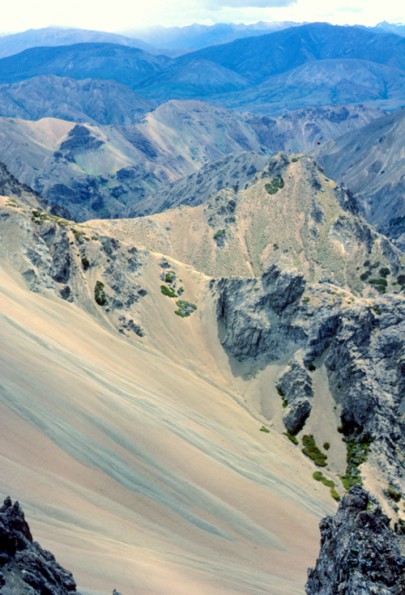Screes of acidic rocks
In this section
-
Inland & alpine
- Basic cliffs, scarps and tors
- Boulderfields of acidic rocks (non-volcanic)
- Boulderfields of calcareous rocks
- Boulderfields of quartzose rocks
- Braided riverbeds
- Calcareous cliffs, scarps and tors
- Calcareous screes
- Cliffs, scarps and tors of acidic rocks
- Cliffs, scarps and tors of quartzose rocks
- Cloud forests
- Frost hollows
- Granitic gravel fields
- Granitic sand plains
- Inland outwash gravels
- Inland saline (salt pans)
- Inland sand dunes
- Limestone erosion pavements
- Moraines
- Old tephra (>500 years) plains (= frost flats)
- Recent lava flows
- Sandstone erosion pavements
- Screes of acidic rocks
- Strongly leached terraces and plains
- Ultrabasic boulderfields
- Ultrabasic cliffs, scarps and tors
- Ultrabasic hills
- Ultrabasic screes
- Volcanic boulderfields
- Volcanic debris flows or lahars
- Volcanic dunes
- Young tephra plains and hillslopes

Ancient scree overlain with young scree, Awatere Valley (Peter Williams)
Screes comprise loose, mobile rock, mostly smaller than boulders, lying on steep slopes (30-40°). Although in some situations screes can form under a forest canopy, mostly they occur as open land. This parent rock category includes the most common rock types of the axial ranges of the North and South Island. Most screes are long-standing features and have existed since the Holocene and the position of their boundaries has been shown to be remarkably static. Stable scree patches support scattered individuals of herbaceous species such as Epilobium glabellum and Poa novae-zelandiae, and an assortment of obligate scree plant species. Some authors divide screes into 'rock-slides' comprised of relatively stable areas of larger rocks and 'shingle-slips' comprising small, fine-grained, usually mobile stones, 2-4 cm in diameter or occasionally up to 10-cm diameter. Scree mobility can be indicated by lichens.
Synonyms
Siliceous scree and loose rock
Notable flora and fauna
Screes support a specialised flora with some species largely restricted to this habitat. Scree endemics include Epilobium pycnostachyum, Senecio glaucophyllus subsp. discoideus, Veronica cheesemanii subsp. cheesemanii, Ranunculus haastii, Lignocarpa diversifolia, Lignocarpa carnosula, Notothlaspi rosulatum, Stellaria roughii, Lobelia roughii, Leptinella atrata subsp. atrata, Leptinella dendyi, Myosotis traversii var. traversii and var. cantabrica, Poa schistacea, and the nationally endangered Ranunculus acraeus, and the naturally uncommon Epilobium forbesii, Wahlenbergia cartilaginea, and Veronica cheesemanii subsp. flabellata. Other threatened or rare plants that occur in this habitat include the declining species Veronica scrupea, Montigena novae-zelandiae, Rachelia glaria and Ranunculus pilifera, and the naturally uncommon species Gentianella magnifica, Montia erythrophylla, Epilobium purpuratum, Veronica kellowiae, Haastia pulvinaris var. minor, Leptinella atrata subsp. luteola, Ranunculus scrithalis, Convolvulus fractosaxosa, and Epilobium aff. glabellum (CHR; pink).
Threatened and rare fauna include the South Island giant scree weta (Deinacrida connectens), the scree skink (Oligosoma waimatense) and the Takitimu gecko (Mokopirirakau cryptozoicus).
Threat status
Not threatened (Holdaway et al. 2012)
Threats
Introduced pines are the main weed threat. Adventive legumes and alders are spreading on some moist screes. Trampling and browsing impacts by introduced mammals (goats, deer, tahr, chamois, hares, possums and rodents) are likely to be present in some sites. Modification of alpine areas around ski resorts can be a threat. Overcollecting of unique scree plants has resulted in local extinctions.
Where do they occur?
Screes on acidic rock are most common on the dry greywacke mountains of the South Island ranging from Marlborough to North Otago, but also occur in NW Nelson, the Richmond Range and Inland Southland and on the North Island in the Kaweka, Kaimanawa and Ruahine ranges. Scree-obligate plants occur more commonly on screes in dry climates.
Further reading
Dawson JW 1988. Scree Plants in Forest Vines to Snow Tussocks: The Story of New Zealand Plants. Victoria University Press, Wellington.
Fisher FJF 1952. Observations on the vegetation of screes of Canterbury, New Zealand. Journal of Ecology 40: 156-167.
Gibbs GW, Richards M 1991. An assessment of the taxonomic and conservation status of the South Island giant scree weta Deinacrida connectens. Contract report (S748) Department of Conservation, Wellington (unpubl.).
Jewell TR, Leschen RAB 2004. A new species of Hoplodactylus (Reptilia: Pygopodidae) from the Takitimu Mountains, South Island, New Zealand. Zootaxa 792: 1-11.
McSaveney MJ, Whitehouse IE 1989. Anthropic erosion of mountain land in Canterbury. New Zealand Journal of Ecology 12(Suppl.): 151-163.
Pierson TC 1982. Classification and hydrological characteristics of scree slope deposits in the northern Craigieburn Range, New Zealand. Journal of Hydrology (NZ) 21(1): 34-60.
Wardle P 1972. Plant succession on greywacke gravel and scree in the subalpine belt in Canterbury. New Zealand Journal of Botany 10: 387-398.
Wardle P 1991. Vegetation of New Zealand. Cambridge University Press. Pp 194.
Links
Shingle scree (Te Ara Encyclopedia of New Zealand)
Scree (Wikipedia)

